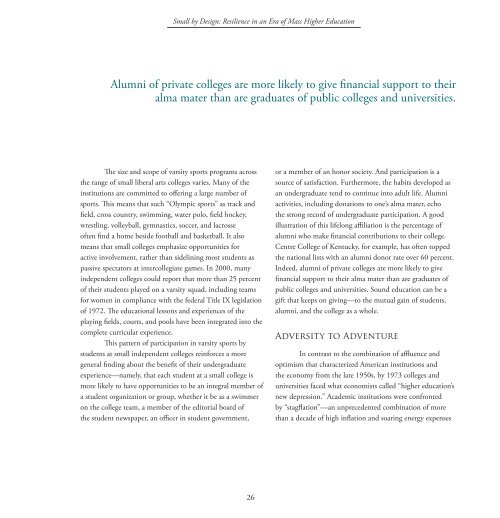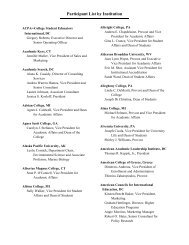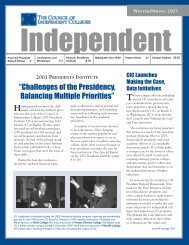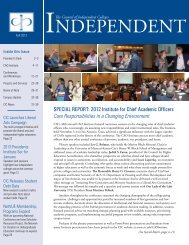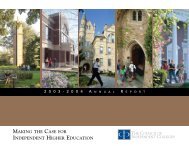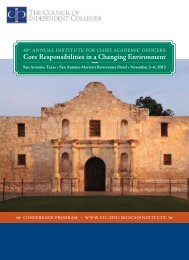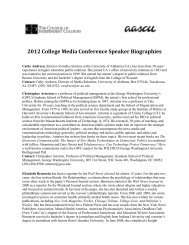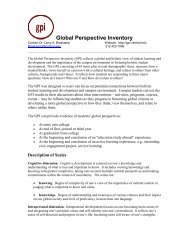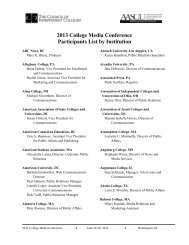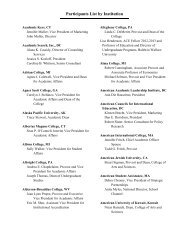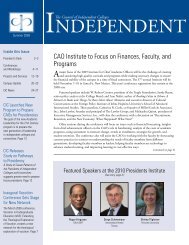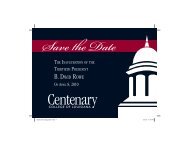Meeting the Challenge: - The Council of Independent Colleges
Meeting the Challenge: - The Council of Independent Colleges
Meeting the Challenge: - The Council of Independent Colleges
You also want an ePaper? Increase the reach of your titles
YUMPU automatically turns print PDFs into web optimized ePapers that Google loves.
Small by Design: Resilience in an Era <strong>of</strong> Mass Higher Education<br />
Alumni <strong>of</strong> private colleges are more likely to give financial support to <strong>the</strong>ir<br />
alma mater than are graduates <strong>of</strong> public colleges and universities.<br />
<strong>The</strong> size and scope <strong>of</strong> varsity sports programs across<br />
<strong>the</strong> range <strong>of</strong> small liberal arts colleges varies. Many <strong>of</strong> <strong>the</strong><br />
institutions are committed to <strong>of</strong>fering a large number <strong>of</strong><br />
sports. This means that such “Olympic sports” as track and<br />
field, cross country, swimming, water polo, field hockey,<br />
wrestling, volleyball, gymnastics, soccer, and lacrosse<br />
<strong>of</strong>ten find a home beside football and basketball. It also<br />
means that small colleges emphasize opportunities for<br />
active involvement, ra<strong>the</strong>r than sidelining most students as<br />
passive spectators at intercollegiate games. In 2000, many<br />
independent colleges could report that more than 25 percent<br />
<strong>of</strong> <strong>the</strong>ir students played on a varsity squad, including teams<br />
for women in compliance with <strong>the</strong> federal Title IX legislation<br />
<strong>of</strong> 1972. <strong>The</strong> educational lessons and experiences <strong>of</strong> <strong>the</strong><br />
playing fields, courts, and pools have been integrated into <strong>the</strong><br />
complete curricular experience.<br />
This pattern <strong>of</strong> participation in varsity sports by<br />
students at small independent colleges reinforces a more<br />
general finding about <strong>the</strong> benefit <strong>of</strong> <strong>the</strong>ir undergraduate<br />
experience—namely, that each student at a small college is<br />
more likely to have opportunities to be an integral member <strong>of</strong><br />
a student organization or group, whe<strong>the</strong>r it be as a swimmer<br />
on <strong>the</strong> college team, a member <strong>of</strong> <strong>the</strong> editorial board <strong>of</strong><br />
<strong>the</strong> student newspaper, an <strong>of</strong>ficer in student government,<br />
or a member <strong>of</strong> an honor society. And participation is a<br />
source <strong>of</strong> satisfaction. Fur<strong>the</strong>rmore, <strong>the</strong> habits developed as<br />
an undergraduate tend to continue into adult life. Alumni<br />
activities, including donations to one’s alma mater, echo<br />
<strong>the</strong> strong record <strong>of</strong> undergraduate participation. A good<br />
illustration <strong>of</strong> this lifelong affiliation is <strong>the</strong> percentage <strong>of</strong><br />
alumni who make financial contributions to <strong>the</strong>ir college.<br />
Centre College <strong>of</strong> Kentucky, for example, has <strong>of</strong>ten topped<br />
<strong>the</strong> national lists with an alumni donor rate over 60 percent.<br />
Indeed, alumni <strong>of</strong> private colleges are more likely to give<br />
financial support to <strong>the</strong>ir alma mater than are graduates <strong>of</strong><br />
public colleges and universities. Sound education can be a<br />
gift that keeps on giving—to <strong>the</strong> mutual gain <strong>of</strong> students,<br />
alumni, and <strong>the</strong> college as a whole.<br />
Adversity to Adventure<br />
In contrast to <strong>the</strong> combination <strong>of</strong> affluence and<br />
optimism that characterized American institutions and<br />
<strong>the</strong> economy from <strong>the</strong> late 1950s, by 1973 colleges and<br />
universities faced what economists called “higher education’s<br />
new depression.” Academic institutions were confronted<br />
by “stagflation”—an unprecedented combination <strong>of</strong> more<br />
than a decade <strong>of</strong> high inflation and soaring energy expenses<br />
26


